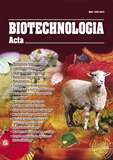ISSN 2410-7751 (Print)
ISSN 2410-776X (Online)

Biotechnologia Acta Т. 18, No. 2, 2025
P. 100-102, Bibliography 6 , Engl.
UDC: 577: 616.03: 546.1
doi: https://doi.org/10.15407/biotech18.02.100
EFFECT OF SELENIUM CITRATE ON THE GLUTATHIONE STATUS AND THYROID HORMONES IN RATS WITH EXPERIMENTALLY INDUCED HYPOTHYROIDISM
O.O. Sushko 1, R.JA. Iskra 2
1 Krupynskyi Lviv Medical Academy, Ukraine
2 Ivan Franko National University of Lviv, Ukraine
Aim. The research purposed to determine the effects of selenium citrate on the characteristics of the antioxidant system and hormone levels in the blood of rats with experimentally induced hypothyroidism.
Materials and Methods. The hypothyroid state was induced using Mercazolil in a dose of 5 mg/kg. Hypothyroid state was determined by the levels of triiodothyronine, thyroxine, and thyroid-stimulating hormone. Animals under the research consumed selenium citrate at doses of 100 and 200 μg/kg of body weight.
Results. It was found that the levels of thyroid hormones significantly decreased during hypothyroidism and had a tendency to normalize under the influence of selenium citrate. Thyroid-stimulating hormone significantly increased during hypothyroidism, though selenium compounds had no effect on its level. Changes of the activity of the glutathione status enzymes were monitored, in particular, glutathione reductase significantly increased and glutathione peroxidase decreased in animals with hypothyroidism compared to control. Selenium citrate in amounts of 100 and 200 μg/kg of body weight significantly reduced glutathione reductase activity and increased glutathione peroxidase activity compared to animals with hypothyroidism.
Conclusions. The obtained results indicate a normalization of hormone levels and glutathione link indicators under the influence of selenium citrate in the blood of rats with experimentally induced hypothyroidism. These results may form the basis for the development of methods and means for the prevention and treatment of hypothyroidism.
Keywords: selenium citrate, glutathione status, hypothyroidism.
© Palladin Institute of Biochemistry of the National Academy of Sciences of Ukraine, 2025
References
1. Taylor, P. N., Albrecht, D., Scholz, A., Gutierrez-Buey, G., Lazarus, J., Dayan, C. M., Okosieme,
O. E. (2018). Global epidemiology of hyperthyroidism and hypothyroidism. Nat. Rev.
Endocrinol., 14, 301–316. https://doi.org/10.1038/nrendo.2018.18
2. Oziol, L., Faure, P., Bertrand, N., Chomard, P.(2003). Inhibition of in vitro macrophage-induced
low density lipoprotein oxidation by thyroid compounds. J. Endocrinol., 177, 137–146. https://doi.
org/10.1677/joe.0.1770137
3. Omrani, H. R., Rahimi, M., Nikseresht, K. (2015). The effect of selenium supplementation on acute
phase reactants and thyroid function tests in hemodialysis patients. Nephrourol. Mon., 7, e24781.
https://doi.org/10.5812/numonthly.24781
4. Winther, K. H., Bonnema, S. J., Cold, F., Debrabant, B., Nybo, M., Cold, S., Hegedus, L. (2015).
Does selenium supplementation affect thyroid function? Results from a randomized, controlled,
double-blinded trial in a Danish population. Eur. J. Endocrinol, 172, 657–667. https://doi.
org/10.1530/EJE-15-0069
5. Campos, C., Casado, A. (2022). Oxidative stress, thyroid dysfunction and down syndrome. Indian
J. Med. Res., 142(2), 113–119.
6. De Vito, P., Balducci, V., Leone, S., Percario, Z., Mangino, G., Davis, P. J., Davis, F. B., ...,
Incerpi, S. (2021). Nongenomic effects of thyroid hormones on the immune system cells: New
targets, old players. Steroids, 77(10), 988–995. https://doi.org/10.1016/j.steroids.2012.02.018

